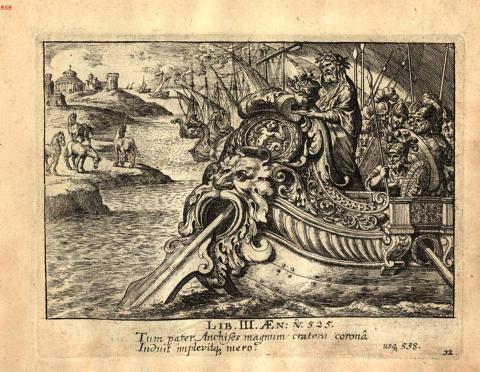Annotations
Anchises, standing in the bow of a ship, offers a sacrifice, as the Trojans see Italy and grazing horses on the bank.
Anchises, im Bug eines Schiffes stehend, bringt ein Opfer dar, als man Italien und am Ufer weidende Pferde sichtet. (Suerbaum)
Engraving from a German children’s picture-book version of the Aeneid by G. J. Lang and G. C. Eimmart, “A tapestry of Roman virtues as seen in Vergil’s Aeneas and his brave deeds, rendered in sparkling engravings, as illustrations of the remarkable deeds of antiquity, for the common benefit of noble youth,” (Peplus virtutum Romanarum in Aenea Virgiliano eiusque rebus fortiter gestis, ad maiorem antiquitatis et rerum lucem, communi iuventutis sacratae bono, aere renitens) (Nuremburg: J.L. Buggel, 1688), pl. 12.


This engraving corresponds to the Trojans first sighting of Italy. At line 525 Virgil describes Anchises’ libation: “tum pater Anchises magnum crater coronua induit implevitque mero, divosque vocavit/ stans celsa in puppi…” A few lines later, at 537 and 538, Aeneas sees the four white horses on the shore depicted in the picture. These horses, which Anchises interprets as an omen of war, are equivalent to the four white stallions of a Roman triumph. In the background are buildings, probably the city of King Latinus. (Lucy McInerney)